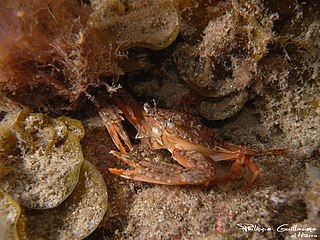
Portunus is a genus of crab which includes several important species for fisheries, such as the blue swimming crab, Portunus pelagicus and the Gazami crab, P. trituberculatus. Other species, such as the three-spotted crab (P. sanguinolentus) are caught as bycatch.

Loch Leven is a fresh water loch located immediately to the east of the burgh of Kinross in Perth and Kinross council area, central Scotland. Roughly triangular, the loch is about 6 km (3.7 mi) at its longest. Prior to the canalisation of the River Leven, and the partial draining of the loch in 1826-36, Loch Leven was considerably larger. The drop in water level by 1.4 m reduced to the loch to 75% of its former size, and exposed several small islands, as well as greatly increasing the size of the existing ones.

Portunus trituberculatus, the gazami crab, Japanese blue crab or horse crab, is the most widely fished species of crab in the world. It is found off the coasts of East Asia and is closely related to Portunus pelagicus.

The Encyclopedia of Life (EOL) is a free, online collaborative encyclopedia intended to document all of the 1.9 million living species known to science. It is compiled from existing databases and from contributions by experts and non-experts throughout the world. It aims to build one "infinitely expandable" page for each species, including video, sound, images, graphics, as well as text. In addition, the Encyclopedia incorporates content from the Biodiversity Heritage Library, which digitizes millions of pages of printed literature from the world's major natural history libraries. The project was initially backed by a US$50 million funding commitment, led by the MacArthur Foundation and the Sloan Foundation, who provided US$20 million and US$5 million, respectively. The additional US$25 million came from five cornerstone institutions—the Field Museum, Harvard University, the Marine Biological Laboratory, the Missouri Botanical Garden, and the Smithsonian Institution. The project was initially led by Jim Edwards and the development team by David Patterson. Today, participating institutions and individual donors continue to support EOL through financial contributions.

Silpha is a genus of the family Silphidae, or carrion beetles, formerly including several North American species. Members of the genus are sometimes called silphids. All North American silphid beetles are now reorganized in either the subfamily Nicrophorinae, with the only genus in North America being Nicrophorus, and subfamily Silphinae, including the genera Aclypea, Heterosilpha, Necrodes, Necrophila, Oiceoptoma, and Thanatophilus. The genus Oxelytrum is sometimes included due to a dubious Texas record, but to date has never been validated. While members of the genus Nicrophorus typically bury carrion for their larvae to feed upon, members of subfamily Silphinae lay their eggs directly on or in a blown carcass. This is because the larvae not only feed on the carrion, but also upon fly maggots. There are 30 species of silphids in North America North of Mexico.

Crab fisheries are fisheries which capture or farm crabs. True crabs make up 20% of all crustaceans caught and farmed worldwide, with about 1.4 million tonnes being consumed annually. The horse crab, Portunus trituberculatus accounts for one quarter of that total. Other important species include flower crabs, snow crabs (Chionoecetes), blue crabs, edible or brown crabs, Dungeness crab and mud crabs, each of which provides more than 20,000 tonnes annually.

iNaturalist is a citizen science project and online social network of naturalists, citizen scientists, and biologists built on the concept of mapping and sharing observations of biodiversity across the globe. iNaturalist may be accessed via its website or from its mobile applications. Observations recorded with iNaturalist provide valuable open data to scientific research projects, conservation agencies, other organizations, and the public. The project has been called "a standard-bearer for natural history mobile applications."

Silphinae is a subfamily of burying beetles or carrion beetles. There are 113 extant species of this subfamily, in two tribus and in 14 genera.

Potemnemus is a genus of longhorn beetles of the subfamily Lamiinae, containing the following species:

Dasygnathus trituberculatus is a species of large scarab beetle native to Australia.

Toxonotus is a genus of fungus weevils in the beetle family Anthribidae. There are about 13 described species in Toxonotus.

Thanatophilus lapponicus, the northern carrion beetle, is a species of carrion beetle in the family Silphidae. It is found in Europe & Northern Asia, Central America, and North America.

Thanatophilus is a genus of carrion beetles in the family Silphidae. There are about 12 described species in Thanatophilus.
Thanatophilus sagax is a species of carrion beetle in the family Silphidae. It is found in North America.
Thanatophilus truncatus is a species of carrion beetle in the family Silphidae. It is found in Central America and North America.
Thanatophilus coloradensis is a species of carrion beetle in the family Silphidae. It is found in North America.
Eunica tatila, the Florida purplewing, is a species of tropical brushfoot in the butterfly family Nymphalidae. It is found in North America.
Urbanus doryssus, the white-tailed longtail, is a species of dicot skipper in the butterfly family Hesperiidae. It is found in Central America, North America, and South America.

Historis acheronta, the tailed cecropian, is a species of crescents, checkerspots, anglewings, etc. in the butterfly family Nymphalidae.

Psychoda is a genus of moth flies in the family Psychodidae. There are more than 400 described species in Psychoda.
















